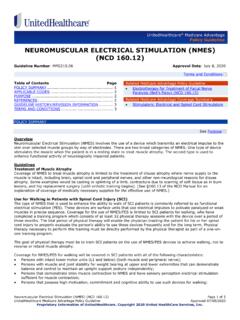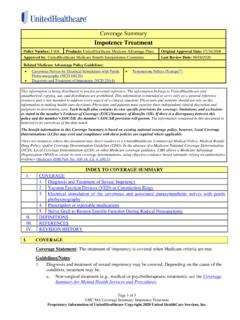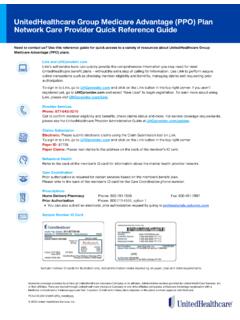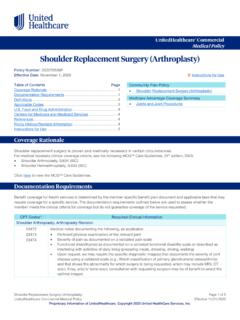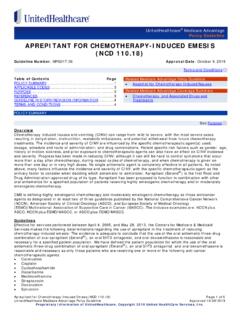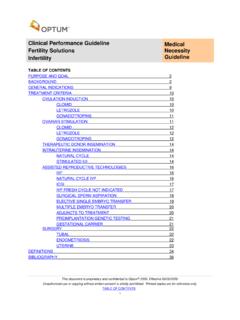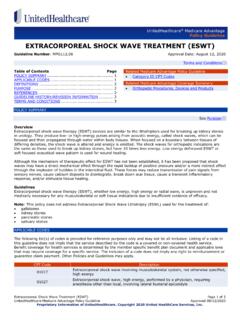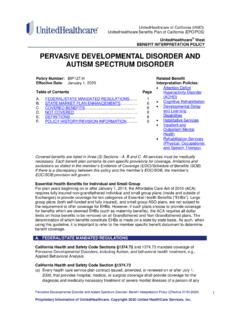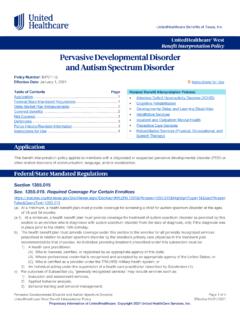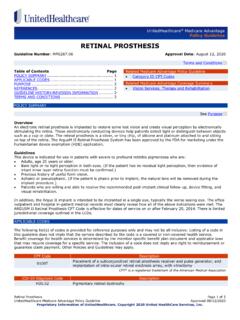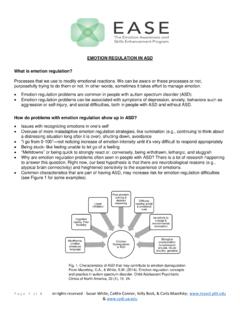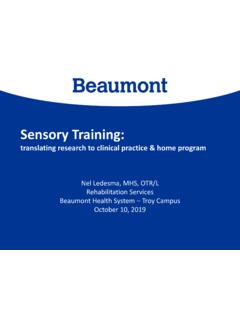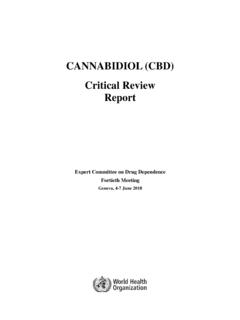Transcription of Transcranial Magnetic Stimulation – Commercial Medical Policy
1 Transcranial Magnetic Stimulation Page 1 of 14 UnitedHealthcare Commercial Medical Policy Effective 04/01/2021 Proprietary Information of UnitedHealthcare. Copyright 2021 United HealthCare Services, Inc. UnitedHealthcare Commercial Medica l Policy Transcranial Magnetic Stimulation Policy Number: 2021T0536N Effective Date: April 1, 2021 Instructions for Use Table of Contents Page Coverage Rationale .. 1 Applicable Codes .. 1 Description of Services .. 2 Clinical Evidence .. 2 Food and Drug Administration .. 11 References .. 11 Policy History/Revision Information .. 13 Instructions for Use .. 14 Coverage Rationale The following are unproven and not medically necessary due to insufficient evidence of efficacy: Transcranial Magnetic Stimulation for treating all Medical ( , non-behavioral) conditions including but not limited to.
2 O Alzheimer s disease o Chronic neuropathic pain o Dystonia o Epilepsy o Headaches o Parkinson s disease o Stroke o Tinnitus Navigated Transcranial Magnetic Stimulation (nTMS) for treatment planning or for diagnosing motor neuron diseases or neurological disorders For Behavioral Disorders, refer to the Optum Behavioral Clinical Policy titled Transcranial Magnetic Stimulation at Optum Provider Express > Clinical Resources > Guidelines/Policies & Manuals > Behavioral Clinical Policies. Applicable Codes The following list(s) of procedure and/or diagnosis codes is provided for reference purposes only and may not be all inclusive.
3 Listing of a code in this Policy does not imply that the service described by the code is a covered or non-covered health service. Benefit coverage for health services is determined by the member specific benefit plan document and applicable laws that may require coverage for a specific service. The inclusion of a code does not imply any right to reimbursement or guarantee claim payment. Other Policies and Guidelines may apply. CPT Code Description 64999 Unlisted procedure, nervous system 90867 Therapeutic repetitive Transcranial Magnetic Stimulation (TMS) treatment; initial, including cortical mapping, motor threshold determination, delivery and management Related Commercial Policies Deep brain and Cortical Stimulation Vagus Nerve Stimulation Community Plan Policy Transcranial Magnetic Stimulation Related Optum Guideline Transcranial Magnetic Stimulation (TMS) Transcranial Magnetic Stimulation Page 2 of 14 UnitedHealthcare Commercial Medical Policy Effective 04/01/2021 Proprietary Information of UnitedHealthcare.
4 Copyright 2021 United HealthCare Services, Inc. CPT Code Description 90868 Therapeutic repetitive Transcranial Magnetic Stimulation (TMS) treatment; subsequent delivery and management, per session 90869 Therapeutic repetitive Transcranial Magnetic Stimulation (TMS) treatment; subsequent motor threshold re-determination with delivery and management CPT is a registered trademark of the American Medical Association Description of Services Transcranial Magnetic Stimulation (TMS) is a method of delivering electrical Stimulation to the brain . In general, single-pulse TMS is used to explore brain functioning and repetitive TMS (rTMS) is used to induce changes in brain activity that lasts beyond the Stimulation period (Klomjai et al.)
5 2015). Single-pulse TMS was originally introduced in 1985 as a noninvasive and safe way to stimulate the cerebral cortex. Activation of the motor cortex by Transcranial Magnetic Stimulation produces contralateral muscular-evoked potentials (MEPs), thus providing a valuable tool for functional mapping of the motor cortex. Technological advances introduced generators capable of producing rapid, repetitive pulses of Magnetic Stimulation . The Magnetic field pulses pass unimpeded through the hair, skin, and skull and into the brain where they induce an electrical current to flow inside the brain without seizures or need for anesthesia.
6 The amount of electricity created is very small and cannot be felt by the individual, but the electric charges cause the neurons to become active and are thought to lead to the release of neurotransmitters such as serotonin, norepinephrine and dopamine. Repetitive TMS (rTMS) is currently under investigation as a treatment for several disorders originating in the cerebral cortex including pain, dystonia, epilepsy, headaches, Parkinson s disease, stroke, and tinnitus. TMS is delivered by various available devices, and treatment has been tested using a variety of protocols, including high frequency delivered over the left dorsolateral prefrontal cortex, low frequency delivered over the right or left dorsolateral prefrontal cortex, bi-lateral delivery, deep TMS in which deeper prefrontal regions are stimulated and theta burst Stimulation that delivers Magnetic pulses that are administered at a rapid speed of delivery.
7 Navigated Transcranial Magnetic Stimulation (nTMS) is being studied as a diagnostic tool to stimulate functional cortical areas at precise anatomical locations to induce measurable responses. This technology is being investigated to map functionally essential motor areas for diagnostic purposes and for treatment planning. Clinical Evidence Therapeutic Transcranial Magnetic Stimulation (TMS) The current evidence is insufficient to determine the efficacy of TMS for treating conditions such as Alzheimer's disease, epilepsy, headaches, pain, Parkinson s disease, stroke, and tinnitus. Due to small sample sizes, short-term follow-ups, and variability in technique and outcome measures, there is insufficient data to conclude that Transcranial Magnetic Stimulation is beneficial for treating these conditions.
8 Alzheimer's Disease (AD) Holczer et al. (2020) conducted a systematic review to examine the presence and extent of methodological issues confounding non-invasive brain Stimulation (NIBS) studies attempting to alleviate the cognitive symptoms of demented patients. However, serious methodological limitations appear to affect the estimates of their efficacy. The focus was on repetitive Transcranial Magnetic Stimulation (rTMS) or tDCS, , the two most frequent NIBS techniques. Patients with mild cognitive impairment (MCI) and Alzheimer s disease (AD) were included. The study reviewed the Stimulation parameters and methods of studies that used TMS or tDCS to alleviate the cognitive symptoms of patients with Alzheimer's disease (AD) and mild cognitive impairment (MCI).
9 The risk of bias was also included in these studies. There were 36 studies identified of which 23 were randomized-controlled trials. More than 75% of randomized-controlled trials involved some levels of bias in at least one domain. Stimulation parameters were highly variable with some ranges of effectiveness emerging. Studies with low risk of bias indicated TMS to be potentially effective for patients with AD or MCI while questioned the efficacy of tDCS. This was the first time the presence and extent of methodical issues affecting TMS and tDCS research involving patients with AD and MCI were examined. The risk of bias frequently affected the domains of the randomization process and selection of the reported data while missing outcome was rare.
10 Unclear reporting was present involving randomization, allocation concealment, and blinding. Methodological awareness can potentially reduce the high variability of the estimates regarding the effectiveness of TMS and tDCS. Studies with low risk of bias delineate a range within TMS parameters seem to be effective but question the efficacy of Transcranial Magnetic Stimulation Page 3 of 14 UnitedHealthcare Commercial Medical Policy Effective 04/01/2021 Proprietary Information of UnitedHealthcare. Copyright 2021 United HealthCare Services, Inc. tDCS. The study also had limitations including the lack of quality assessment of the non-RCTs as well as a quantitative analysis.
